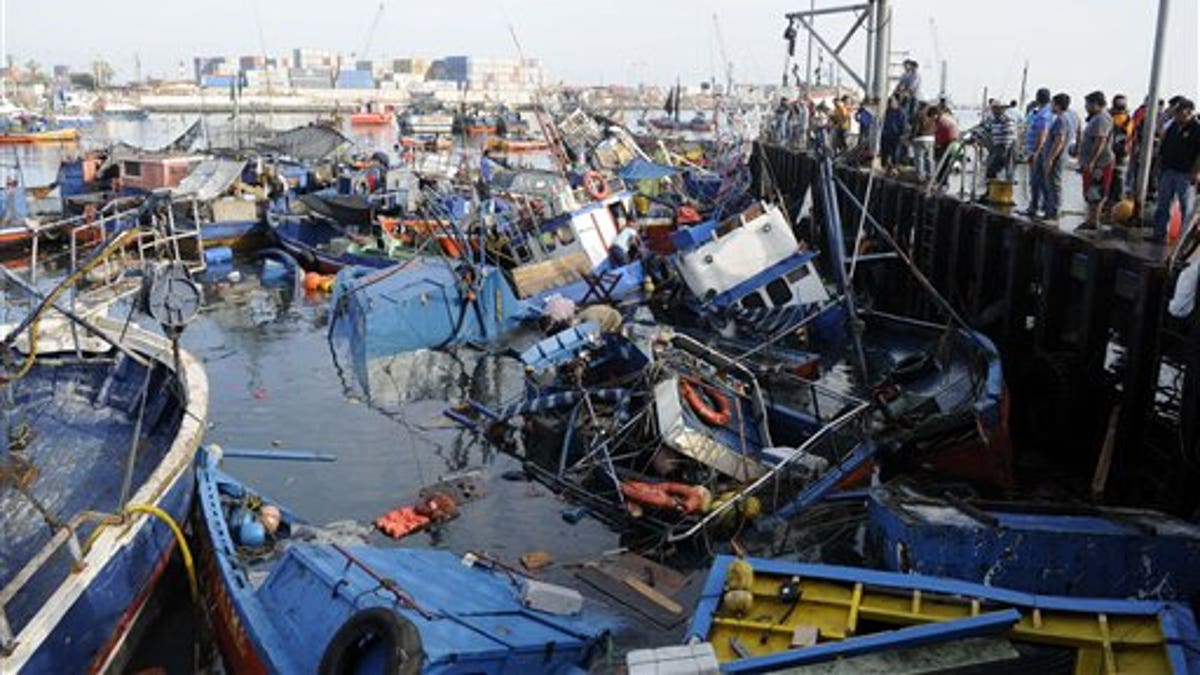
Fishing boats washed ashore by a small tsunami, sit in Caleta Riquelme, adjacent to the port, in the northern town of Iquique, Chile, after magnitude 8.2 earthqauke struck the northen coast of Chile, Wednesday, April 2, 2014. Authorities lifted tsunami warnings for Chiles long coastline early Wednesday. Six people were crushed to death or suffered fatal heart attacks, a remarkably low toll for such a powerful shift in the Earths crust. (AP Photo/Cristian Viveros) NO PUBLICAR EN CHILE
The magnitude-8.2 earthquake that rocked northern Chile late Tuesday left at least 6 people dead, sent tsunami waves crashing toward the coast and drew comparisons to the country’s even more destructive earthquake in 2010.
But many Chileans – used to the rumblings of their temperamental earth – said the quake could have been much worse.
Chile is situated in a zone of immense seismic activity, given its location where the Nazca, South American and Antarctic plates converge, and has seen 14 magnitude-6.0 or greater earthquakes in the last 10 years alone.
Authorities in Chile found only light damage when they began to dig out early Wednesday morning in the northern port city of Iquique, where President Michelle Bachelet arrived and declared a state of emergency. While thousands of resident were evacuated from Iquique and the surrounding towns amid a tsunami warning, most returned to their homes shortly after the warning was lifted and residents said they were anxiously relieved.
“Everything is calm and under control for now,” Cesár Galdame of Iquique’s Holiday Inn Express told Fox News Latino. “So far there have been no problems besides some broken glasses and things.”
Galdame said the hotel was evacuated shortly after the earthquake hit and guests were taken inland to avoid any threat of death or injury from the almost 7 feet high tsunami waves. After about 2 hours, residents in Iquique were allowed to return to the city.
The quake’s damage included destroyed fishing boats, mudslide-covered roads, a ruined airport tarmac, small business fires and the collapse of a number of adobe homes in the nearby town of Arica. About 300 inmates also escaped from a women's prison in the city of Iquique, forcing the closure of the border with Peru, but officials said some two dozen had been captured early Wednesday.
Located on the southern part of the so-called Pacific Ring of Fire, Chile experiences some of the most frequent seismic activity in the world.
Around 75 percent of the world's seismic energy is released at the edge of the Pacific, where the thinner Pacific plate is forced beneath thicker continental crust along ‘subduction zones.’ This more than 24,000-long band of seismicity stretches up from southern Chile to Alaska, the Aleutians and across to Japan, China, the Philippines, Indonesia and Australasia, the British Geological Survey reported.
The U.S. Geological Survey said Tuesday’s temblor was centered in the Pacific Ocean 61 northwest of Iquique and more than 20 significant aftershocks followed, including one of magnitude 6.2. A number of smaller quakes struck the same area in the preceding weeks.
The quake was so strong that the shaking experienced in Bolivia's capital about 290 miles away was the equivalent of a magnitude-4.5 tremor, authorities there said.
Much of Chile – including from the capital of Santiago up to the country’s border with Peru – lies on a zone of extreme earthquake hazard, with the densely populated Santiago region and the northern part of the country receiving more yearly seismic activity than other parts of the country, according to the U.S. Geological Survey.
With this data and the recent history of destructive quakes, Chileans say the threat of a deadly earthquake is something that they live with every day.
“We expect them at any time and it’s something we’re used to,” said Francisco Mejias, a Chilean immigrant to the U.S. and bakery owner who grew up in the coastal city of Viña del Mar. “It’s like tornados here in the Midwest; it’s a feeling we have to live with all the time.”
The Associated Press contributed to this report.
